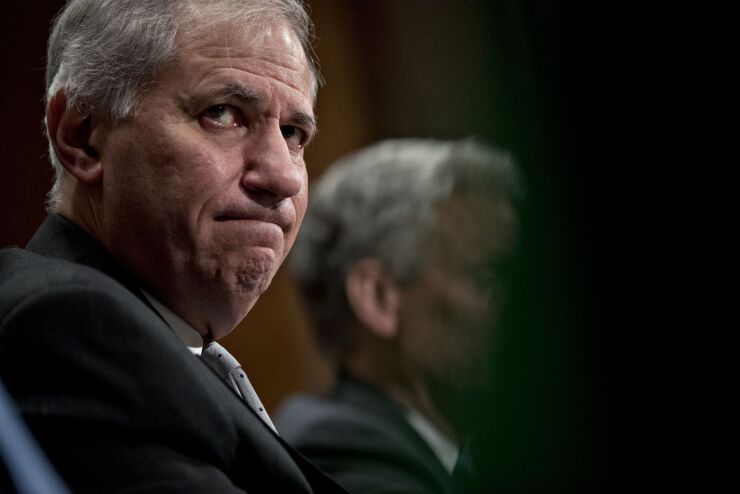
WASHINGTON — The Federal Deposit Insurance Corp.'s Board of Directors finalized a rule Wednesday that requires FDIC-insured depository institutions to display a new digital official FDIC sign near the name of their bank on all websites and mobile platforms by 2025. The agency will also require conspicuous physical signs in nontraditional bank facilities and explicit labeling of insured and non-deposit products. The FDIC board approved the agency's 2024 operating budget as well, with a 6.3% decrease from the previous year.
The final sign and advertising rule — approved at a
"For many consumers, these channels may serve as the primary method of accessing banking products, acting essentially as a 'digital teller window,'" Gruenberg said. "It is important to require a digital sign so that customers can confirm when they are interacting directly with a bank rather than with a non–bank entity, and to clarify when their funds are insured by the FDIC and when they are not."
The FDIC noted that the revision was due to the substantially more online nature of banking since the rule's last significant update in 2006. A new digital black and navy-blue version of the classic black and gold FDIC official sign — which has been required at teller windows since the agency was founded in the 1930s — will now be displayed by banks across digital platforms beginning January 1, 2025.
Considering the
Under the final rule, for branches where insured deposits are received in areas other than classic teller windows, the insured institution must display the official FDIC sign conspicuously in a size large enough to be legible from such alternative deposit taking stations.
Across all channels both online and physical, the FDIC will also now require the use of signs to help customers explicitly differentiate insured-deposit products from non-deposit products. For the latter, firms will need to also note such products "are not insured by the FDIC, are not deposits, and may lose value."
Additionally, the final rule clarifies the FDIC's regulatory approach to instances where institutions misrepresent deposit insurance coverage.
The final rule provides examples of scenarios where misleading information may confuse consumers about whether they are engaging with an insured depository institution and expressly prohibits the use of FDIC-related imagery or terminology in marketing materials that incorrectly imply uninsured financial products or entities are FDIC-insured.
This regulatory update comes on the heels of the agency's efforts to educate the public on deposit insurance coverage. The agency's "
In the same meeting, the FDIC Board of Directors approved the 2024 operating budget, which stood at $2.96 billion. While this represents a 6.3% decrease from the previous year, Gruenberg noted the budget allocates resources to core FDIC objectives crucial to staving off future bank failures, like resources for monitoring and supervising large banks.
"That includes resources to address recommendations made by our chief risk officer in reviews of FDIC supervision of the institutions that failed," said Chairman Gruenberg. "New staffing resources are also provided to ensure that the FDIC is prepared to act quickly and effectively to resolve the failure of another large regional bank if that were to become necessary."
The budget also allocates resources to monitor potential risks with emerging technological practices at Insured depository institutions including the
FDIC Vice Chairman Travis Hill — who supported the rule despite some reservations — remarked approvingly that unlike the proposed rule, the final rule omitted a definition of crypto assets and did not express a view on whether financial products using blockchain technology are legally considered deposits under the Federal Deposit Insurance Act.
"Crypto assets generally are not 'deposits' under the FDI Act and should be subject to the same FDIC disclosure regime as other non–deposit products, the question of whether and under what circumstances tokenized deposits, dollar tokens, and other similar products should be treated and reported as 'deposits' is an important one for the FDIC and the broader financial system," he said. "This rulemaking is not the appropriate vehicle for consideration of this issue, and I support the amendments in the final rule."
Consumer financial advocate Dennis M. Kelleher, co-founder, president, and CEO of Better Markets, said the final rule would help restore the confidence and potency of the FDIC logo. He noted that the FDIC has taken multiple
"The FDIC deposit insurance is the gold standard for trust, confidence, and protection, which is why too many in the crypto industry want to misleadingly if not falsely suggest to crypto investors that their money is protected by the FDIC," he said. "That false comfort not only harms investors, but also the insurance program, insured banks, and the broader banking system as people lose faith in the FDIC [and] that's what today's rule aims to stop."






